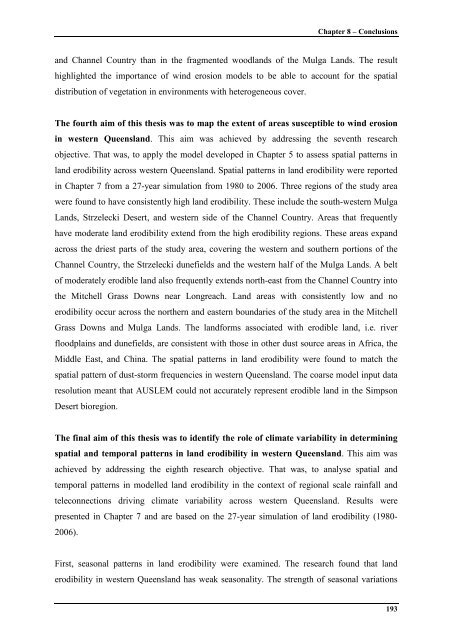Wind Erosion in Western Queensland Australia
Modelling Land Susceptibility to Wind Erosion in Western ... - Ninti One
Modelling Land Susceptibility to Wind Erosion in Western ... - Ninti One
You also want an ePaper? Increase the reach of your titles
YUMPU automatically turns print PDFs into web optimized ePapers that Google loves.
Chapter 8 – Conclusionsand Channel Country than <strong>in</strong> the fragmented woodlands of the Mulga Lands. The resulthighlighted the importance of w<strong>in</strong>d erosion models to be able to account for the spatialdistribution of vegetation <strong>in</strong> environments with heterogeneous cover.The fourth aim of this thesis was to map the extent of areas susceptible to w<strong>in</strong>d erosion<strong>in</strong> western <strong>Queensland</strong>. This aim was achieved by address<strong>in</strong>g the seventh researchobjective. That was, to apply the model developed <strong>in</strong> Chapter 5 to assess spatial patterns <strong>in</strong>land erodibility across western <strong>Queensland</strong>. Spatial patterns <strong>in</strong> land erodibility were reported<strong>in</strong> Chapter 7 from a 27-year simulation from 1980 to 2006. Three regions of the study areawere found to have consistently high land erodibility. These <strong>in</strong>clude the south-western MulgaLands, Strzelecki Desert, and western side of the Channel Country. Areas that frequentlyhave moderate land erodibility extend from the high erodibility regions. These areas expandacross the driest parts of the study area, cover<strong>in</strong>g the western and southern portions of theChannel Country, the Strzelecki dunefields and the western half of the Mulga Lands. A beltof moderately erodible land also frequently extends north-east from the Channel Country <strong>in</strong>tothe Mitchell Grass Downs near Longreach. Land areas with consistently low and noerodibility occur across the northern and eastern boundaries of the study area <strong>in</strong> the MitchellGrass Downs and Mulga Lands. The landforms associated with erodible land, i.e. riverfloodpla<strong>in</strong>s and dunefields, are consistent with those <strong>in</strong> other dust source areas <strong>in</strong> Africa, theMiddle East, and Ch<strong>in</strong>a. The spatial patterns <strong>in</strong> land erodibility were found to match thespatial pattern of dust-storm frequencies <strong>in</strong> western <strong>Queensland</strong>. The coarse model <strong>in</strong>put dataresolution meant that AUSLEM could not accurately represent erodible land <strong>in</strong> the SimpsonDesert bioregion.The f<strong>in</strong>al aim of this thesis was to identify the role of climate variability <strong>in</strong> determ<strong>in</strong><strong>in</strong>gspatial and temporal patterns <strong>in</strong> land erodibility <strong>in</strong> western <strong>Queensland</strong>. This aim wasachieved by address<strong>in</strong>g the eighth research objective. That was, to analyse spatial andtemporal patterns <strong>in</strong> modelled land erodibility <strong>in</strong> the context of regional scale ra<strong>in</strong>fall andteleconnections driv<strong>in</strong>g climate variability across western <strong>Queensland</strong>. Results werepresented <strong>in</strong> Chapter 7 and are based on the 27-year simulation of land erodibility (1980-2006).First, seasonal patterns <strong>in</strong> land erodibility were exam<strong>in</strong>ed. The research found that landerodibility <strong>in</strong> western <strong>Queensland</strong> has weak seasonality. The strength of seasonal variations193
















